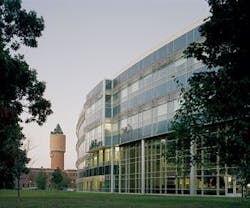Newsworthy
A new McDonald’s restaurant is going green – and educating its customers and staff about its green initiatives.
The new building, which was designed by the National Restaurant Designers division at LMHT Associates and is owned and operated by Ric Richards of Richards Advantage Inc., is registered with the U.S. Green Building Council (USGBC) for the LEED® for Retail Pilot program and includes several green features, such as fuel-efficient parking spaces with electrical plug-in outlets, water-efficient equipment, recycling areas, and more. The restaurant will also feature an LCD touchscreen to allow users to browse through a program to learn more about the building’s energy efficiency and the company’s environmental-improvement efforts.
The touchscreen will feature images of the outside surrounding areas and a 360-degree digital tour of the building’s interior (where users can select different features to learn more about the innovative designs); it will also provide local transportation information, including pedestrian and bicycle paths, as well as a green quiz.
Water Efficiency is Key to Green Building
According to a SmartMarket Report sponsored by Chicago Faucets, Water Use in Buildings: Achieving Business Performance Benefits through Efficiency, water efficiency will become increasingly important to green building efforts in commercial buildings over the next 5 years.
The study indicates that 42 percent of building owners report that three-quarters of their projects include water-efficient practices, 85 percent of commercial building industry players say that water efficiency will be an important part of green building in 2013, and 50 percent expect to incorporate water-efficient practices into at least 50 percent of their building projects.
Additionally, the study found that companies planning to use water-efficient practices and technology will reduce water use by 15 percent, decrease energy use by 10 to 11 percent, and reduce operating costs by 11 to 12 percent.
College of Health and Human Services is First Higher-Ed Project with LEED® Gold
The College of Health and Human Services at Western Michigan University (WMU), which was designed several years ago by SmithGroup, is the first higher-education project in the country to earn the LEED for Existing Buildings (LEED-EB) Version 2.0 Gold certification from the U.S. Green Building Council (USGBC).
The 4-year-old, 200,000-square-foot building implemented new sustainable building practices in part with a $15,000 grant from the U.S. Department of Energy. Sustainable features include cork flooring and motion-activated lights, heating, and cooling.
Achieving LEED-EB Gold involved documenting sustainable practices with stormwater management, site erosion and light pollution control, water efficiency in restrooms and landscaping, ozone-free cooling systems, recycling and waste management, sustainable cleaning products and policies, increased ventilation standards, daylight harvesting and lighting control, and more.
Economy isn’t Slowing Pest-Control Efforts
A recent survey by BOMA Intl. and Atlanta-based Orkin Inc. shows that the economy isn’t causing property managers to slow or reduce pest-management efforts. In fact, 90 percent of surveyed BOMA members said they haven’t scaled down their pest-control programs, and 70 percent of those surveyed stated that pest control is a “very important” part of their building-management strategy.
Green pest control and tenant involvement are also important to property managers’ pest-control programs: 68 percent of respondents said that it’s “extremely important” to have an environmentally friendly pest-control program, and 52 percent of respondents are taking steps to educate their tenants on their pest-management programs.
Studies Show that Hospital Design Affects Patient Care
Results from more than 1,500 emerging studies indicate that hospital design can reduce medical errors, infections and falls, and patient stress. For example, a study at Bronson Methodist Hospital found that single-patient rooms with well-located sinks and better airflow designs lowered hospital-acquired infection rates by 11 percent.
Additionally, research from the Center for Health Design’s Pebble Project showed that lowering noise levels around patients improved self-reported sleep quality by nearly 50 percent, and other studies showed that natural light and nature scenes can help with patient depression and lowering reported pain levels.
BOMA Intl. Launches Web-Based EER
BOMA Intl. has launched the first Web-based edition of its Experience Exchange Report® (EER), the most comprehensive resource for financial performance information on private and public office buildings in the United States and Canada. Previously available in print or on CDs, this new online format combines the most comprehensive data on income and operating expenses markets with sophisticated Web-based technology.
The EER is developed in collaboration with Kingsley Associates, and it contains data from nearly 5,000 buildings in more than 300 markets. It includes national trends analysis and market-level reports on many facility types, including special-use facilities, such as medical office buildings, corporate facilities, financial buildings, agency-managed, and all electric buildings, and it will feature custom search tools. It will also give users the ability to import data tables.
Businesses are Deficient in Disaster Preparedness
The recent survey, 2009 Disaster Recovery & Business Continuity Survey, conducted by Agility Recovery Solutions and Hughes Marketing Group, surveyed more than 700 business owners and executives throughout North America, and found that small- and mid-sized businesses are unprepared for disasters and misled by existing back-up plans.
The survey revealed that, while 75 percent of companies say they can have their employees back to work within days of a disaster, only 28 percent have access to alternative office space, 41 percent have access to mobile office space, 54 percent could acquire temporary office equipment, and 57 percent have access to power generators. Additionally, 90 percent of smaller companies (fewer than 100 employees) said they spend less than 1 day per month maintaining continuity plans.
Data Center Energy Efficiency and Monitoring on Rise
More than 120 data center, facility, and IT managers shared information about the current state of, and future plans for, their data centers in the biannual Data Center Users Group (DCUG) survey, conducted by Emerson Network Power.
The DCUG survey showed that energy efficiency and adequate monitoring concerns continue to increase, with 47 percent of respondents listing energy efficiency and 46 percent listing adequate monitoring in their top three concerns.
The survey also revealed that 61 percent of respondents had to cut budgets due to the economy, and 35 percent had to delay data-center projects. Fifty-two (52) percent of respondents indicated that, when budgets permit, future facilities would be designed to support densities of 10 kW and 20 kW per rack to save space, support blade servers, and reduce energy costs.




